Stifttabletts
Mit einem präzisen Stift kannst du auf einem reaktionsschnellen Pad skizzieren, zeichnen und Bilder bearbeiten und deine Werke auf einem Bildschirm begutachten.

Herzlich willkommen beim nächsten Teil dieses Lernprogramms, bei dem wir ein Gesicht zeichnen, indem wir es Stück für Stück zusammensetzen. Du hast hoffentlich schon etliche Tipps und Tricks bekommen, die dir helfen, Figuren zu konzipieren oder Portraits und Karikaturen zu zeichnen. Heute geht es um die Frage: “Wie zeichne ich eine Nase?”
In diesem Lernprogramm lernst du Schritt für Schritt, eine Nase zu zeichnen.
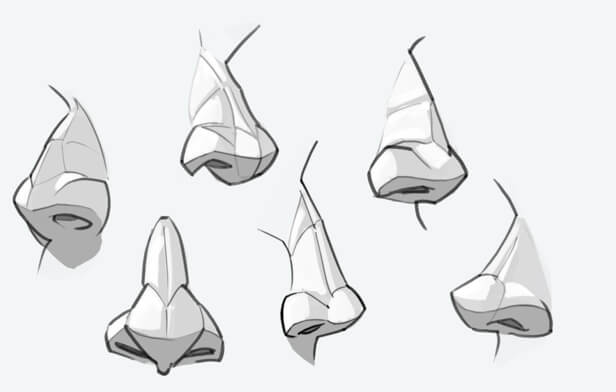

Der Schwierigste beim Zeichnen der Nase ist wahrscheinlich einfach die Tatsache, dass sie dreidimensional aus dem Gesicht herausragt. Um dies für uns einfacher zu machen, reduzieren wir die Nase zunächst auf eine geometrische Form, so wie hier im Bild gezeigt. Es handelt sich um eine langgestreckte Pyramide. Sie soll uns dabei helfen, die Nase aus jedem beliebigen Winkel zeichnen zu können.
Mit etwas Übung wirst du die Pyramide vielleicht gar nicht mehr benötigen, um eine Nase zu zeichnen. Aber sie kann dir helfen, wenn du ein Gesicht aus einem etwas ungewöhnlicheren Winkel zeichnen möchtest und nicht recht weißt, wie die Nase denn nun aussehen soll.
Um sicher zu gehen, dass die Pyramide richtig gezeichnet ist, beginnen wir mit einem Kreuz auf der Grundfläche und zeichnen vom Mittelpunkt aus die Höhe ein (im Bild gestrichelt). Damit haben wir alle Eckpunkte einschließlich der Spitze und müssen diese nur noch verbinden.

Wie du siehst, ergeben sich aus den verschiedenen Winkeln ganz unterschiedliche Formen für die Pyramide. Wenn du schon etwas geübter bist, kannst du auch versuchen, die Pyramide frei zu zeichnen. Sicherer ist es jedoch, mit dem Kreuz auf der Grundfläche zu beginnen.
Im Folgenden wird diese Grundfläche der menschliche Kopf sein.

Wenn du lernen möchtest, wie man eine Nase zeichnet, solltest du mit einem Gesicht in Frontalansicht beginnen. Ich verwende hier natürlich wieder die Kopfformen aus den vorangegangenen Lernprogrammen.

(1) Als Erstes brauchen wir das Dreieck zwischen den Augen, das wir schon im Lernprogramm zum Zeichnen der Augen kennengelernt haben. Das Dreieck kennzeichnet den Bereich zwischen Augenbrauen und Nasenbein.

(2) Als Nächstes zeichnen wir das Kreuz unserer Pyramide. An diesem Punkt können wir bereits bestimmen, wie breit unsere Nase sein soll. Eine Durchschnittsnase ist in etwa so breit wie der Abstand zwischen den Augen. Daher werde ich für meine Nase diesen Abstand einhalten.
Das Kreuz bestimmt außerdem, ob die Nase später eher nach oben oder nach unten zeigt. Je höher du den Querstrich des Kreuzes ansetzt, desto weiter zeigt die Nase nach oben.
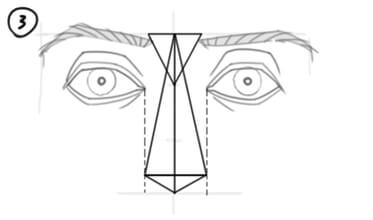
(3) In der Frontalansicht brauchen wir für unsere Pyramide keine Höhe einzeichnen, weil die Pyramide aus dieser Perspektive nämlich bereits aussieht wie ein Kreuz. Aber das gilt nur für die Frontalansicht.

(4) Nun machen wir aus der Pyramide eine Nase. An der Spitze der Pyramide befindet sich die Nasenspitze. Dafür zeichnen wir einfach einen Kreis. Je kleiner du den Kreis zeichnest, desto spitzer sieht die Nase später aus. Manchmal bietet es sich an, für die Nasenspitze nicht einen Kreis, sondern ein Sechseck oder eine Raute zu zeichnen. Aber lass uns für diese Nase beim Kreis bleiben.

(5) An den beiden unteren Ecken unserer Pyramide zeichnen wir die Nasenflügel ein. Du kannst dich dabei an den Linien orientieren, wie sie im Bild dargestellt sind. Unterhalb der Nasenspitze deuten wir mit zwei weiteren Linien die Nasenscheidewand an, also den Bereich zwischen den Nasenlöchern. Er sollte nach unten hin schmaler werden.

(6) Von der Unterkante her lassen sich jetzt die Nasenlöcher zeichnen. Dafür zeichnest du einfach zwei umgedrehte, schmale Us, die leicht nach außen gebogen sind. Achte darauf, dass die Nasenlöcher oben an der Querlinie der Pyramide enden.

(7) Eine äußerst hilfreiche Linie, deren Bedeutung oft unterschätzt wird, ist die Grenze zwischen Ober- und Unterseite der Nase. Sie eignet sich super, wenn du später beim Kolorieren herausfinden möchtest, wo die Licht- und wo die Schattenseite der Nase ist. Aber auch für eine reine Strichzeichnung ist sie wunderbar geeignet, um Dreidimensionalität zu suggerieren.
Zeichne die Linie wie eine Welle und folge dabei der Unterkante des Nasenspitzen-Kreises. Ich nenne sie "Nasenspitzenkantenwelle“. Auf Deutsch ist der Name ziemlich lustig.

(8) Kommen wir jetzt zum Zeichnen des Nasenrückens. Er ist nicht bei jeder Nase gleichermaßen ausgeprägt, manchmal reicht es, ihn nur anzudeuten. Aber es ist wichtig zu wissen, dass er, wie im Bild gezeigt, aus zwei Bereichen besteht, die zur Mitte hin etwas dicker werden. Der obere Bereich ist das Nasenbein. Hier befindet sich ein Knochen direkt unter der Haut. Unterhalb dieser Grenze sind keine Knochen mehr.
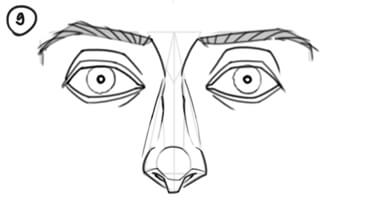
(9) Nach dieser Konstruktion lässt sich die Nase jetzt sehr leicht zeichnerisch gestalten. Es liegt an dir, zu entscheiden, welche Linien du hervorheben und welche du nur andeuten möchtest. Ich habe die Seiten der Nasenspitze entfernt, um den Übergang von Nasenspitze zu Nasenflügel weicher zu gestalten. Am Nasenrücken habe ich den Knochen des Nasenbeins etwas hervorgehoben. Außerdem habe ich die Ränder der beiden Dreiecke noch betont.

Abstrahieren und reduzieren: Gerade bei den Umrissen der Nase ist das sehr hilfreich. Wenn das Gesicht, das du zeichnest, nur etwa einen Zentimeter groß ist, wirst du dich wahrscheinlich nicht lange mit der Nase aufhalten. Entscheide also je nach Bild, wie weit du ins Detail gehen möchtest. Manchmal reichen wenige Striche, um eine Nase anzudeuten. Aber immer dann, wenn du dir nicht sicher bist, wie und wo die entsprechenden Linien sein sollten, solltest du sorgfältig vorgehen, damit die Nase am Ende nicht seltsam aussieht.

(1) Im Profil sieht die Nase ganz anders aus als von vorn. Aber wir können sie auf dieselbe Weise konstruieren. Wir beginnen wieder mit dem Dreieck zwischen den Augenbrauen. Im Profil wird dieses Dreieck allerdings zu einer Linie, da wir es ja von der Seite betrachten.
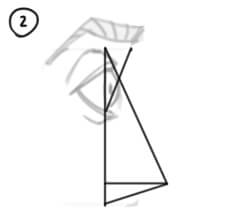
(2) Die Pyramide setzen wir hinter der Dreiecks-Linie an, sodass die Einbuchtung ungefähr auf Höhe des oberen Augenlids entsteht.

(3) Für die Nasenspitze im Profil verwenden wir eine Raute. Zeichne die Raute am besten nicht mit harten, geraden Linien, sondern mit leicht nach außen gewölbten, schwungvollen Strichen. So wird Deine Nase weniger kantig.

(4) Wie zuvor setzen wir den Nasenflügel an der Pyramidenkante an. Natürlich sehen wir im Profil nur einen Nasenflügel. Unterhalb der Nasenspitze schließen wir mit einer fast horizontalen Linie an. Darunter beginnt dann auch schon die Kieferpartie.

(5) Das Nasenloch ist aus dieser Perspektive ziemlich schmal oder auch gar nicht zu sehen. Um es anzudeuten, zeichnen wir die Unterkante des Nasenflügels ein. Die Linie für die Nasenflügel-Unterkante kann sowohl an der Nasenspitze beginnen als auch an der Pyramidenecke. Das bemerkst du, wenn du die drei Varianten miteinander vergleichst. Ich habe mich entschieden, sie unabhängig einzuzeichnen. Das geht auch.
(6) Nasen haben ganz unterschiedliche Silhouetten, die sehr charakteristisch sein können. Du brauchst genau sieben Striche entlang des Pyramiden-Dachs.

(7) Und wieder können wir ein paar der Konstruktionslinien entfernen und andere ergänzen. Zwei sehr wirkungsvolle Linien sind die „Nasenspitzenkantenwelle“ (im Bild von rechts markiert) und eine Andeutung des Wangenknochens (von links).
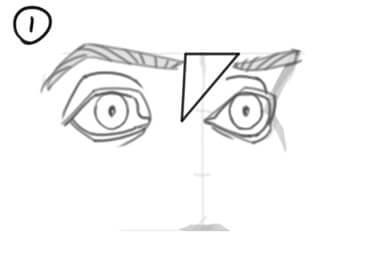
(1) Im Halbprofil ist unsere räumliche Vorstellungskraft etwas stärker gefordert als beim Profil oder in der Frontalansicht. Wie du siehst wird das Dreieck zwischen den Augenbrauen etwas nach links verzerrt.

(2) Lass uns dieses Mal ganz gewissenhaft sein und zuerst wieder den Abstand zwischen den Augen für die Pyramide abtragen.

(3) Damit können wir das Kreuz für die Grundfläche einzeichnen.
(4) Vom Mittelpunkt aus bestimmen wir die Höhe der Pyramide, d.h. wie weit die Nase aus dem Gesicht herausragen soll.
(5) Nun müssen wir nur noch die Eckpunkte verbinden, und unsere Pyramide ist fertig.

(6) Für die Nasenspitze wählen wir eine etwas fortgeschrittenere Form: Stell dir das Sechseck als gewölbtes, dreidimensionales Objekt vor, ähnlich wie eine Halbkugel oder ein Suppenteller. Damit werden in dieser gedrehten Perspektive die Winkel des Sechsecks auf der linken Seite etwas flacher. Das muss nicht ganz präzise konstruiert sein, aber auf diese Weise wirkt die Nase natürlicher.

(7) Die Linien für den Nasenflügel beginnen wie üblich an der Pyramidenkante. Ich habe mich hier für ein markantes, scharfkantiges Nasenloch entschieden.
(8) Auch der Nasenrücken und die Nasenunterseite lassen sich, je nach Nase, etwas schwungvoller oder massiver gestalten.

(9) Unsere Nasenspitze besteht eigentlich aus zwei getrennten Seiten. Manchmal sieht man diese Trennung der Seiten in Form einer Falte, die durch die Mitte der Nasenspitze verläuft. Wir wollen das bei dieser Nase versuchen, und zeichnen die mittige Falte ein.
(10) Der Übergang von der Nasenspitzenfalte zum Nasenrücken verläuft V-förmig. Das bedeutet, wir ersetzen die obere Seite unseres Nasenspitzen-Sechsecks durch ein V.
(11) Die "Nasenspitzenkantenwelle" lassen wir dieses Mal nicht unterhalb der Nasenspitze verlaufen, sondern mittendurch. Außerdem darf sie auch etwas an den kantigen Stil angepasst werden.
(12) Noch einige dünne Linien, um den Nasenrücken und die Pyramidenkanten zu verstärken. Bei unserer Nase führt die mittige Falte bis zum Nasenbein hinauf.

(13) Entferne nicht gleich alle Konstruktionslinien. Manche wirken auch in der finalen Strichzeichnung ganz gut. Ich habe einige davon einfach etwas heller gemacht – die, die ich nicht so sehr betonen wollte. Das gedrehte, gewölbte Sechseck der Nasenspitze ist so organisch, dass es auch in der finalen Zeichnung noch funktioniert.
Von unten sehen Nasen ganz anders aus! Hier ist eine Anleitung, wie du Nasen ganz einfach von unten zeichnen kannst.

(1) Wir orientieren uns, wie immer, an der Pyramide. Von unten betrachtet sieht sie aus wie ein Dreieck mit Mittelachse.

(2) Oben am Dreieck sitzt die Nasenspitze wieder als Kreis oder Sechseck.
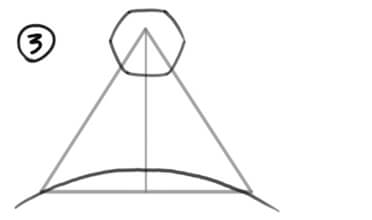
(3) Die Kieferpartie schließt in dieser Perspektive direkt an die Nase an. Sie ist aber nicht flach sondern rund. Genau wie die Zahnreihen. Daher müssen wir nun die flache Unterkante der Pyramide daran anpassen, indem wir die Rundung der Kieferpartie einzeichnen.

(4) Die beiden Nasenflügel sind im Prinzip Verbindungslinien zwischen Pyramidenecke und Nasenspitze. Um den Nasenflügeln Breite zu geben und sie schwungvoll aussehen zu lassen, kannst du sie in jeweils zwei eleganten Schwüngen zeichnen, wie im Bild zu sehen.

(5) Zwischen Nasenspitze und Kiefer sehen wir das untere Ende der Nasenscheidewand.

(6) Etwas weiter im Inneren der Nase wird die Nasenscheidewand dicker. Wir deuten dies an, indem wir rechts und links der Nasenscheidewand jeweils eine Art Beule einzeichnen.

(7) Die Nasenlöcher haben die Form langgezogener, verbeulter Os.
(8) Außen verläuft die Nasenlochlinie parallel zum Nasenflügel. Oben trifft sie auf die Nasenspitze, unten überlappt sie die Beule.

(9) Und natürlich ist es dunkel im Nasenloch. Aber wir wollen ganz bewusst noch nicht zu sehr auf Schattierungen eingehen, sondern lieber erst mal bei den Linien bleiben. Natürlich kannst du die Nasenlöcher trotzdem dunkel ausmalen. Aber mach das erst, wenn alle Umrisse und Konstruktionslinien an ihrem Platz sind.

(1) Versuchen wir zum Schluss, die Nase schräg von unten zu zeichnen. Unser oberes Dreieck wird aus diesem Blickwinkel länger und natürlich wieder seitlich verzerrt.

(2) In dieser Perspektive knifflig: die Grundfläche für die Pyramide finden. Aber aus der Profilansicht wissen wir, dass sie das obere Dreieck etwa in der Hälfte schneidet. Und die Unterkante der Pyramide trifft auf die Hilfslinie unserer Kopfform. Mit diesen beiden Punkten lässt sich die Mittelachse einzeichnen.
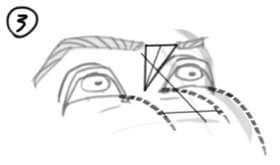
(3) Wenn wir, wie zuvor, die Breite der Nase vom Augenabstand ableiten möchten, kann das etwas verwirrend sein. Denn die gestrichelten Linien sind nun nicht mehr gerade, sondern sie verlaufen entlang der Rundung unserer Wangen. (Genau genommen wäre das im Halbprofil auch so gewesen.

(4) Die Höhenachse der Pyramide sollte in dieselbe Richtung zeigen, in die auch der gesamte Kopf ausgerichtet ist.

(5) Damit ist der schwierigste Teil geschafft. Die Pyramide ist errichtet.
(6) Weil die Rundung für die Kieferpartie an die Blickrichtung angepasst werden muss, ist sie auf der uns zugewandten Seite flacher und breiter. Genauer gesagt zeichnen wir hier den oberen Teil einer verdrehten Ellipse.

(7) Das Sechseck bietet sich auch in dieser Zeichnung als Nasenspitze an. Auch lohnt es sich wieder, die dreidimensionale Wölbung anzudeuten.
(8) Nun können wir vorgehen wie in der Anleitung.
(9) Die beiden Beulen links und rechts der Nasenscheidewand sind in dieser Perspektive nicht im gleichen Maße zu sehen. Die rechte ist zum größten Teil von der Nasenscheidewand verdeckt.

(10) Auch vom rechten Nasenloch sehen wir weniger als vom linken.
(11) Und auch der Nasenrücken wird sehr schmal. Die Nase selbst verkürzt sich, je weiter wir nach unten schauen.
(12) Die "Nasenspitzenkantenwelle" befindet sich nun genau entlang der roten Linie.

(13) Zum Abschluss dürfen die Nasenlöcher auch etwas dunkler werden. Auch leichte Schraffuren können bestimmte Kanten etwas entschärfen, wie hier zwischen Nasenspitze und Nasenscheidewand.

Ich hoffe, ich konnte dir ein bisschen helfen, den "Angstgegner" Nase zu besiegen. Und vielleicht wird ja die Nase sogar dein neues Lieblingskörperteil? Vor allem, wenn du Comicfiguren entwirfst oder Karikaturen zeichnest, kann die Nase zu einem wirklich unterhaltsamen Gebilde werden, das zu zeichnen richtig Spaß macht. Dabei kannst du dich voll ausleben. Probier es einfach aus!
Bis zum nächsten Mal!
Dank eines 13,3-Zoll-Bildschirms mit natürlichem Oberflächenwiderstand und minimaler Reflexion erzeugt das Wacom One ein vertrautes Gefühl wie mit dem Stift auf Papier. Der Stift liegt leicht und natürlich in der Hand und verwandelt sich in der gewählten Software in einen Bleistift, Pinsel oder Kreide. Alles, was du brauchst, um eine natürlich aussehende Nase zu zeichnen. Die Kreativsoftware ist im Lieferumfang enthalten, ebenso wie die Möglichkeit, eine Verbindung zu deinem Computer oder bestimmten Android-Geräten herzustellen.

Wacom One 13 Stift-Display
Zeichne, entwerfe und kreiere direkt mit einem präzisen Stift auf einem hochauflösenden Bildschirm.

Mit einem präzisen Stift kannst du auf einem reaktionsschnellen Pad skizzieren, zeichnen und Bilder bearbeiten und deine Werke auf einem Bildschirm begutachten.

Zeichne, entwerfe und kreiere direkt mit einem präzisen Stift auf einem hochauflösenden Bildschirm.

Schreibe mit einem Stift auf Papier und verwandle deine handschriftlichen in digitale Notizen.
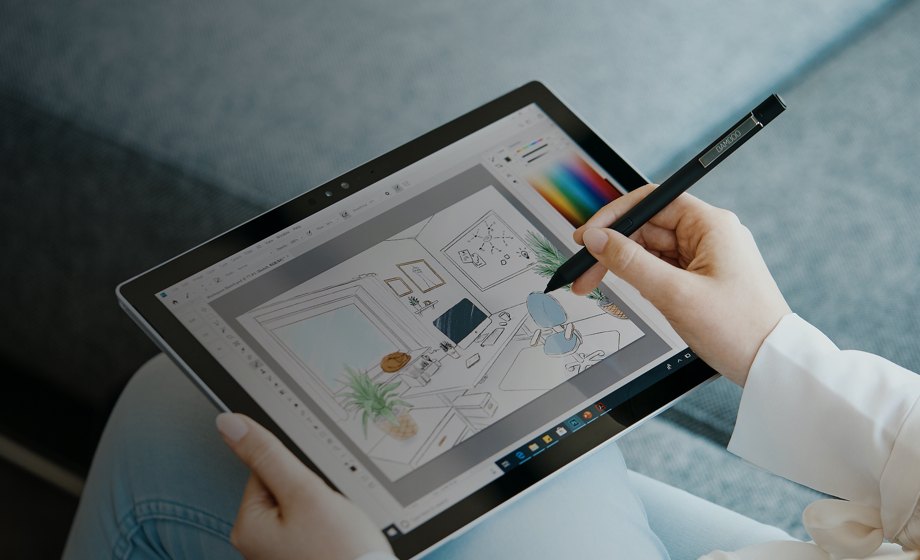
Mit einem Wacom Eingabestift kannst du auf deinem mobilen Gerät schreiben und handschriftlich Notizen machen.
Wacom verfolgt die Vision, Menschen und Technologie durch natürliche Schnittstellentechnologien enger zusammenzubringen. Diese Vision hat das Unternehmen zum weltweit führenden Hersteller interaktiver Stifttabletts und -Displays sowie digitaler Eingabestifte und Lösungen für die Speicherung und Verarbeitung digitaler Signaturen gemacht. Die fortschrittliche Technologie der intuitiven Eingabegeräte von Wacom wurde bei einigen der aufregendsten Werke in den Bereichen Digital Art, Film, Spezialeffekte, Mode und Design weltweit eingesetzt und bietet Geschäfts- und Privatanwendern als führende Schnittstellentechnologie die Möglichkeit, ihre Persönlichkeit zum Ausdruck zu bringen. Wacom wurde 1983 gegründet und ist ein globales Unternehmen mit Sitz in Japan (Tokyo Stock Exchange 6727) mit weltweiten Tochtergesellschaften und Niederlassungen zur Bereitstellung von Marketing und Vertrieb in über 150 Ländern.